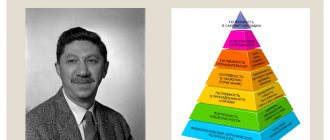The famous Italian writer Gianni Rodari, using a romantic comparison, showed how the association is formed. He compared the spoken word to a stone thrown into a river. The stone made waves on the water, which made everything in it sway: a leaf, a reed, a water lily, a fishing rod float. Only waves from the spoken word arise in our cerebral cortex; what you hear evokes images, memories, thoughts.
What is an association
Association
- this is a naturally occurring connection between individual objects, phenomena, facts, reflected in our consciousness and enshrined in memory. It is important that associations do not exist in external reality, but are generated by the human brain.
The idea of the existence of associations arose in ancient times; Plato, Aristotle and other ancient thinkers discussed this. However, in the Middle Ages, the development of science stopped in many ways, including in this area. The term “association” itself was introduced only by John Locke, an English scientist of the seventeenth century.
How do such relationships arise? The human brain is a complex information processing machine. The data entering it is subjected to various processing, including analysis, synthesis, and comparison with each other. At this time, short-term nerve connections are formed in the brain, due to which the similarity of any objects and phenomena is revealed.
For example, a person sees an object. The visual image enters the brain, which thoroughly studies it, and it generates similar images from those that the person has seen before. This is how an association arises.
Thus, association is the result of the coexistence in our minds of a large number of images, between which there may be some similarity.
Something similar can be observed on the Internet – in modern search engines. As soon as we start entering the first letters of the query, the search engine immediately offers possible options that have the typed combination of letters. Thus, “in the mind” of the World Wide Web (or a separate computer), previously downloaded “images” are generated that have some resemblance to the new information.
Associations are a product of developed abstract thinking. Therefore, they are characteristic only of human consciousness and the consciousness of other higher primates. For example, the Yerkish language, which has only a written form and is intended for communication with monkeys, is based on the ability to build associations. The more developed a person’s intellect, the greater the number of different associations to one subject he can generate. It is known that people with intellectual disabilities have certain difficulties in understanding the connections between objects.
I.M. Sechenov, an outstanding Russian scientist, devoted himself to the study of associations. Studying the reflexes of the brain, he came to the conclusion that associations are, as it were, the contact of a previous reflex with a subsequent one.
Connections between phenomena and objects arise spontaneously and continuously, since sensations and reflexes of the brain also arise continuously. Irritants that cause associations can be both external factors (seen, heard, etc.) and internal (for example, abdominal pain makes you remember about eating too fatty a piece of meat at night). Even thoughts can serve as irritants. It often happens that some random thought gives rise to a whole cascade of other thoughts and images. The English researcher T. Buzan aptly compared associations with fireworks: first one thought arises, which “explodes”, giving rise to several new ones, which also “explode” and give rise to many more thoughts - and so on many times.
Exercises for developing associative thinking
Want to try association games? This is the case when games develop:
- Take any two words that are not related in meaning, and try to gradually create a semantic associative chain leading from one to the other. For example: a car and a tree. The chain could be like this: car – road – forest – tree.
- Think of a few words (for example: bottle, beads, window). Choose association words for them that are similar in one or more characteristics (for example: glass, hard, sparkling, green).
- Choose associations that unite all the words at the same time. For example: cold, shiny - ice, diamond, metal.
- If you are on a walk or on the road, and you have a travel companion, come up with any first word and, in turn, lead a chain of associations from it. When an association is not clear, explain its appearance. It's fun, interesting and develops associative thinking.
- Come up with unusual associations. For example, wallet - money is a common, expected association. What else can you keep in your wallet? A lottery ticket, a lock of hair, an amulet, a note, a key?
- There is an interesting test that does not take much time, but allows you to play with associations and look into your subconscious and understand what is bothering you. This is the first step towards a solution, right? You can simply come up with 16 any words, or you can use auxiliary initial letters. But you shouldn’t think for a long time, you need to write the first thing that comes to mind and be honest with yourself (if your goal is to get to know yourself better and solve your problem). You can use nouns, adjectives, adverbs, phrases. So, if you decide to use letters (it’s easier to start with), take a piece of paper and write down the following letters vertically on the left: t, d, b, m, g, a, g, o, k, p, c, n, z , p, l, s. Now, opposite each of them, write a word starting with that letter - the first one that comes to mind. Now take the resulting words in pairs, selecting an association for every two consecutive words running vertically. Write down associations next to each pair of words. You will get 8 words. Then again, vertically from top to bottom, combine the two resulting words and again write down the emerging associations. Now there will be 4 of them. Combine them in pairs, write down two new associations. By combining them, you get the key association, the most important one. Associations helped in the study of the subconscious, they were used by S. Freud, then by C. Jung, and are still used by many psychoanalysts (and not only to this day). By using the creative component of your personality, during such a test you can look into your subconscious and find ways to solve the problem, if any. In any case, by putting associations and thoughts on paper, we subject them to analysis, look deeper into ourselves and understand better.
Associations in psychology: main types
Connections between phenomena and objects may affect one or another aspect of them.
In this regard, associations of various types are distinguished:
- Associations by similarity
. Objects are similar in appearance to each other: an apple is a ball, a light bulb is a pear, a spoon is a shovel, etc. - Associations by contrast
. In this case, objects have opposite characteristics: black - white, wet - dry, heavy - light, etc. They are considered the most complex type of associations, and they have not yet been sufficiently studied. - Associations by contiguity in time or space
. In this case, both objects are located close to each other in space or time: summer - vacation, winter - snow, table - chair, etc. - Causal associations
. Objects here are the cause and effect of each other: a light bulb is light, rain is a puddle, poison is death, etc. - Associations by meaning
. These are relationships between objects that reflect a person’s personal experience and may be incomprehensible to the uninitiated. For example: airplane - love. For an ordinary person, there is no connection between these concepts; however, for someone who once flew on a plane and met a girl with whom he fell in love, this pair of concepts has an absolutely concrete and unambiguous connection.
The emergence of associations is an important condition for full-fledged thinking.
Their formation is influenced by several factors
:
- The speed of nervous processes, which determines the speed of brain reflexes
. The higher this speed, the faster associations arise and the more diverse they are. - Memory and the information stored in it
. A person with a good memory will generate richer and deeper associations, therefore, the results of thinking in this case will be more original. - Imagination
. When associative connections are born, the emerging images undergo transformation, their elements are combined in different combinations. This is how the imagination works, and its work is extremely important for the functioning of thinking as a whole. - Subconscious
. Associative processes spread throughout the brain, affecting the subconscious area. This part of thinking is usually beyond our observation and control, and association is one of the few ways to get there.
Usually associations are of an individual nature, because they are connected with personal experience. However, among them there are some that are common to a large number of people, and even some that cover the majority of people. Thus, most people associate snow with winter, and heat with summer.
Associative theory of thinking
The first ideas about the universal laws of human mental life were associated with the formation of associations . In the 17th century, the psychology of thinking had not yet been identified as a separate section, and thinking was not considered as a special form of human activity. The development of thinking was understood as a process of accumulation of associations.
The associative theory of thinking is one of the earliest. Its supporters believed that thinking is an innate ability and comes down to associations connecting traces of the past and impressions of present experience. Unfortunately, this theory could not explain the creative nature of the thinking process, the specificity of its content and the patterns of its occurrence.
However, based on the learning process, the associative theory of thinking highlighted several very significant points for the development of thinking:
- The importance of using visual material in the learning process;
- The realization that learning is possible only through sensory knowledge, i.e. through images and representations.
- Understanding that associations expand the boundaries of abilities, through them consciousness is stimulated, activating the processes of comparison, analysis, and generalization.
Use of association methods in psychodiagnostics
Associative connections can be used in psychodiagnostics to study human mental states. Scientists became interested in this problem at the dawn of psychology as a science. Thus, Sigmund Freud, one of the founders of the science of the unconscious, believed that the subconscious contains repressed desires and instincts of a person that contradict the demands of society. These repressed desires are driven into the “very corner of the brain,” but they do not disappear completely and continue to influence a person’s thinking and behavior. He develops certain phobias, he does strange things, he even develops mental and physical illnesses. Repressed desires, as Freud believed, can be identified using associative diagnostics.
Associative connections arise spontaneously and carry information about existing suppressed instincts and desires. Freud used the method of free association, which is still used today. The identified associative connections allow the specialist to make an accurate diagnosis.
This method is very simple, although it looks strange. The patient should sit comfortably, relax and talk about anything. At the same time, he speaks exclusively about what first comes to his mind.
Currently, some psychologists do not use free associative connections, but rather more organized and controlled ones by a specialist.
To identify associative connections, specialists analyze many aspects of the patient’s life. This is, for example, creativity. When a subject draws a scene, he will certainly use the associative connections that arise.
Of particular interest for study is associative thinking. It is often opposed to logical thinking, and there are certain reasons for this. This kind of thinking allows you to quickly connect information from different areas to solving a problem. This type of thinking acts as if bypassing logic. The solution to the problem in this case can be not only faster, but also deeper, and the approach to this solution can be non-standard.
Associative thinking can be developed, and in the modern world it is advisable to do this. Psychologists have developed many techniques for developing associative thinking skills.
This attention to this type of thinking is explained, in particular, by the fact that logical methods are relatively simple, and at the present stage of human development it is often necessary to solve more complex problems; In addition, logical thinking is increasingly becoming the prerogative of computers, and therefore people are moving on to solving issues where a machine is fundamentally unable to cope. However, researchers nowadays are trying to teach artificial intelligence associative thinking, and there have already been some successes in this direction.
Associative thinking is the area in which human individuality is most clearly manifested. Since most associative connections are of deeply “personal” origin. In our time, one might say, the very understanding of the essence of man is changing. If previously it was customary to hide and suppress personal experience in order to better comply with “social norms,” today it is the personal approach to various things that becomes more profitable. In the future, it is quite possible that a person in his activities will be guided mainly by associative thinking.
Three principles of mnemonics
There are many different mnemonics, but they all follow three principles.
Using Associations
The fundamental property of the psyche is associativity. The brain is a perfect machine for building connections between different images and concepts. The contents of memory are long, complexly organized chains of associations. It’s worth remembering Christmas and New Year, and a decorated Christmas tree, champagne and Olivier salad, the smell of tangerines and congratulations come to mind. If a person is in the mood for childhood memories, the Christmas tree will remind you of a matinee in kindergarten with Father Frost and Snow Maiden, gifts and a festive costume. The pragmatist will be plunged into sadness from counting expenses. The believer will remember the gospel story about the birth of Jesus Christ.
You already know that the secret to a good memory is not so much memorization as it is retrieval of information. What is memorized will be more likely to be preserved if it is tied to what is already known. Based on the chain of associations, it can be easily remembered at the right time. This leads to the first principle of mnemonics: to remember something, associate it with something that is familiar to you, that you can easily remember.
Encoding information with images
You already know the importance of imagination for good memory. Pictures are easier to remember than words and numbers. Hence the second principle of mnemonics: transform what you need to remember into pictures. The first and second principles of mnemonics are used together. Suppose you need to remember exactly and for a long time the code of an automatic storage cell designed for cache communication: 855411. You may need this code in a few years.
Imagine numbers as pictures (the principle of coding through visual images) and connect the pictures together (the principle of associations). The number 8 looks like a large woman, 5 looks like a circus bicycle with one wheel and a handlebar seat, 4 looks like a chair, 1 looks like a broom. A woman (8) rides two circus bicycles (55). One is not enough for her, because she is heavy. To keep these bicycles together, she tied them to a chair (4), on which she sits. But the bicycles are still single-wheeled, and she keeps her balance like a tightrope walker, with the help of two brooms (11). She goes, of course, to the station, in the building of which there is a luggage storage room. Visualize this picture vividly, and the code will no longer be erased from your memory.
A little advice: it’s better if the images can be seen not only. They will be remembered more strongly if they sound, have texture, smell, taste. Remember Shereshevsky with his synesthetic perception. If you imagine a tree, imagine it in detail: it is spreading, with young tender foliage, smells of fresh greenery, with rough warm bark, on which droplets of sticky, bitter resin glisten.
Emotional attitude
A person saves his energy and does not like to do unnecessary work. The brain selects priority tasks to complete depending on the strength of the emotions associated with them. A predator that poses a direct threat causes fear - you need to fight it or you need to run away from it. Extreme thirst causes anxiety and forces you to look for water. The smell of rotten food causes disgust, which protects against possible poisoning. Events associated with strong emotions force us to learn: avoid the paths of predators, remember the way to a water source, beware of spoiled food.
Emotions activate memory. If you ask an ordinary person to name events that happened to him several years ago, most likely he will remember the most important milestones in his life: the birth of children, meeting or parting with a life partner, moving, changing jobs, exciting travels. All these events at one time aroused strong emotions and were therefore remembered. Everything else, as a rule, is erased from memory as something ordinary and of no interest. In other words, you only remember what you need to remember and what you really care about.
The third principle of mnemonics: form an emotional attitude towards the memorized information. Do you remember the code for the storage locker from the previous paragraph? Why do you think? Partly because you were surprised or confused by the absurdity of the described comical image of a woman riding unicycles tied to a chair and trying to keep her balance with two brooms. You will learn mnemonics. Don’t let their absurdity bother you; the good thing about it is that it evokes emotions in you, which means it allows you to reliably remember and quickly reproduce what you remember.
Impaired associative thinking
Violations of associative thinking are expressed in changes in its pace, focus and harmony. Serious painful disorders of associative thinking are the subject of study in the literature on psychiatry and clinical psychology, in the section of psychopathology.
Some patterns of disturbances in the thought process were identified. Based on the symptoms of disorders, disorders are divided, for example, into form and content. In the first case, we are talking about violations of the associative process of thinking (the way a person thinks), and in the second - violations of judgment (what a person thinks, various kinds of obsessive states, delusions, super-black ideas). Below we will consider only some types of disorders of associative thinking:
1. By changing the pace of thinking:
- Acceleration, a noticeably faster pace of processing information, generating ideas, making decisions, and sometimes a leap of ideas. This acceleration is characteristic of manic states.
- Slowing down the pace, excessive delay in thinking and making decisions.
- An involuntary intrusion of thoughts (mentism), interfering with the thought process, leading off the topic.
- Stopping thinking is a break in the flow of thoughts, their involuntary stop.
2. By mobility, liveliness of the thinking process:
- An abundance of detail, minor details, unimportant to the topic.
- Excessive thoroughness, aggravating the previous point with unnecessary distracting associations and details.
- The viscosity of thoughts, in which thinking ceases to be productive, the thread of conversation is lost.
3. According to the grammatical structure of speech:
- The use of cliches, ready-made cliches, templates or questions when constructing an answer, that is, the use of speech stereotypes.
- Repeating meaningless words, sounds or phrases.
- Incoherent repetition of words or their combinations, in which there is no logical or grammatical structure.
4. By focus:
- Excessive ornateness when expressing a simple thought.
- Slipping off the topic into a lengthy discussion on an abstract association, followed by a return to the topic.
- Verbose empty and lengthy ranting without purpose, “about nothing” (reasoning).
- Directing efforts not at resolving the issue, but at executing the protocol (formalism).
- Consideration of an issue from different angles, with different evaluation criteria, changing levels of generalization, which makes it impossible to make a final decision (diversity).
- Fuzzy, contradictory use of concepts, when it is almost impossible to understand what is being said (amorphousness).
- Violations of the logic of thinking, in which either premises, or cause-and-effect relationships, or evidence suffer.
- Symbolism that is understandable only to the patient himself, and to no one else.
- Pathological finding of new meanings in words, based, for example, on the number of letters or on their rhyming with one or another (for example, “happy” or “unlucky”) word.
- Autistic thinking is one that concerns only the patient’s inner world, closed to outsiders.
- Archaic thinking - it is based on ancient stereotypes, judgments, views that are far from modernity.
- Perseveration (persistence, persistence) - in this case, a person persistently repeats words, phrases or deeds, even if the relevant context has already been exhausted.
- Discontinuity (lack of logical connection between concepts, judgments and conclusions), although the grammatical structure of speech may not be disrupted.
To keep the brain in good shape, the comprehensive development of its cognitive functions, such as attention, thinking, memory and perception, is important. To develop them, you can use regular classes with the help of exciting online games performed in the form of exercises for the development of thinking in adults.
We sincerely wish you a useful and exciting pastime and success in self-development!
Thinking
join the discussion
Share with your friends
Content
People have the ability, during the thought process when perceiving a concept, to actualize the involuntary appearance of another image. Mental association is the most important feature of the human mind.
Links[edit]
- Dictionary.com
- 21st Century Lexicon Dictionary.com
- Gough, Harrison G. Studying creativity using word association tests.
Journal of Applied Psychology, Vol. 61(3), June 1976, pp. 348-353. - ↑
Vance Packard,
"Hidden Persuasions"
, Penguin, 1961 paperback edition, page 129 - Jung, Carl G. (1910). "Method of association". American Journal of Psychology
.
21
(2):219–269. DOI: 10.2307/1413002. Retrieved November 16, 2013.










